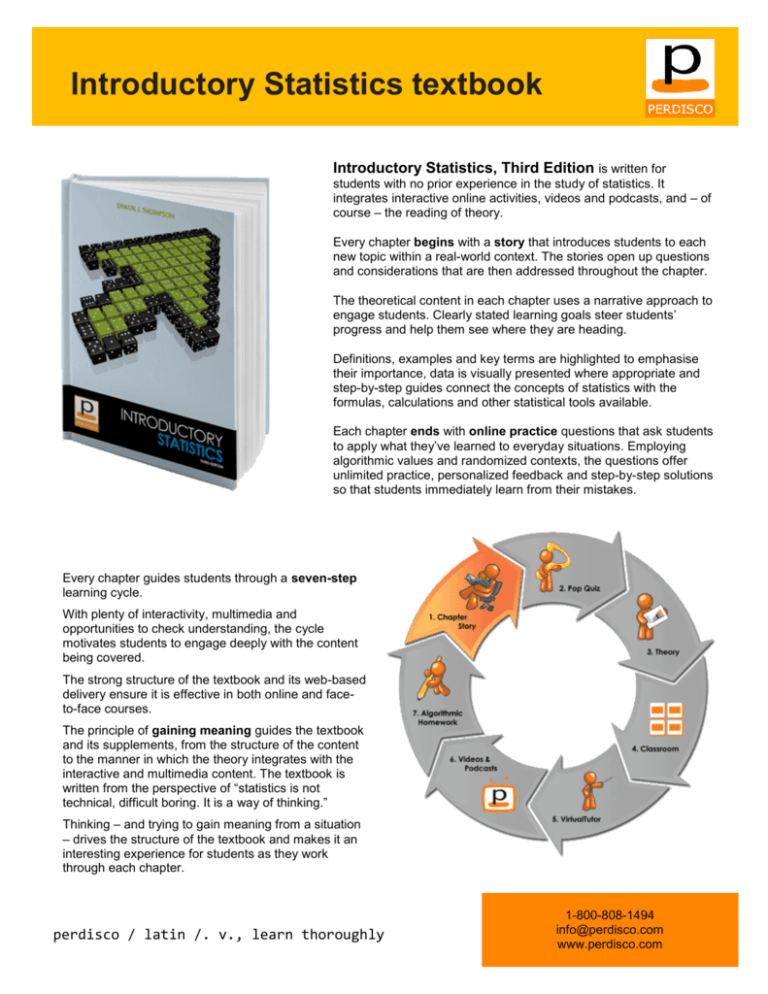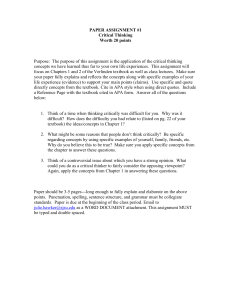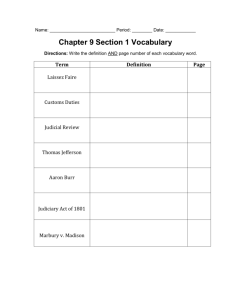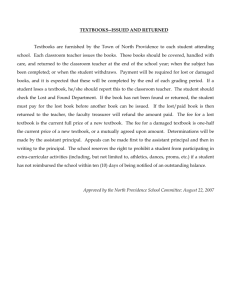Introductory Statistics textbook
advertisement

Introductory Statistics textbook I Introductory Statistics, Third Edition is written for students with no prior experience in the study of statistics. It integrates interactive online activities, videos and podcasts, and – of course – the reading of theory. Every chapter begins with a story that introduces students to each new topic within a real-world context. The stories open up questions and considerations that are then addressed throughout the chapter. The theoretical content in each chapter uses a narrative approach to engage students. Clearly stated learning goals steer students’ progress and help them see where they are heading. Definitions, examples and key terms are highlighted to emphasise their importance, data is visually presented where appropriate and step-by-step guides connect the concepts of statistics with the formulas, calculations and other statistical tools available. Each chapter ends with online practice questions that ask students to apply what they’ve learned to everyday situations. Employing algorithmic values and randomized contexts, the questions offer unlimited practice, personalized feedback and step-by-step solutions so that students immediately learn from their mistakes. Every chapter guides students through a seven-step learning cycle. With plenty of interactivity, multimedia and opportunities to check understanding, the cycle motivates students to engage deeply with the content being covered. The strong structure of the textbook and its web-based delivery ensure it is effective in both online and faceto-face courses. The principle of gaining meaning guides the textbook and its supplements, from the structure of the content to the manner in which the theory integrates with the interactive and multimedia content. The textbook is written from the perspective of “statistics is not technical, difficult boring. It is a way of thinking.” Thinking – and trying to gain meaning from a situation – drives the structure of the textbook and makes it an interesting experience for students as they work through each chapter. perdisco / latin /. v., learn thoroughly 1-800-808-1494 info@perdisco.com www.perdisco.com Introductory Statistics textbook What makes statistics students happy? Practice and feedback! “The homework was easy to follow and the feedback was great.” “The practice questions are great. The feedback given is very helpful, and being able to practice before doing the assessments was the best of any math website I have used.” “I love that I can use the practice problems as many times as I want and if I get a problem wrong they explain why what I answered was wrong. I also like that I can print out a problem that I find difficult or want to study more.” “I like the accessibility to questions with answers that make the learning experience fun to do and that you can do at your own pace and time.” “I liked that the feedback was explained in a great detail. It allowed me to understand the problem better and prepare me for more problems like it in the future.” “The practice problems were a huge help! It was great to see types of questions that we'd see on the graded assignment before we were actually graded on them. It also helped me figure out which parts of the material I was struggling with.” The author “ … focus on the student has been my guiding influence in the instructional design of this textbook - both through the path the content takes and through the integrated feature set that supports students. Every chapter contains a complete set of learning tools and I would hope that in their entirety, students find them informative, supportive and fun. I certainly enjoyed writing and creating them. I have written each component of each chapter (for example, the videos, online questions, pop quizzes) to motivate students to delve into the content and engage at a deeper level than other texts lead them to…” Dr Shaun J Thompson Why digital? The digital format has many advantages for students. It is a cost effective resource, using technology allows a high level of interactivity and feedback, using multimedia makes the information interesting and accessible, practice opportunities are embedded with the reading of content (with immediate feedback) and it is one less thing to carry around! Instructor tools - Summary slides are provided for each chapter and are fully editable. - Algorithmic homework links are available for every chapter of the textbook and can be customized. - Regular reports keep you up to date with your students’ progress and performance. - The question bank can be used for final exam purposes. “I can’t tell you how pleased I am to have found Thompson’s text. It is one of the most complete packages I have seen.” Professor Ralph A. Leal, Metropolitan College of New York perdisco / latin /. v., learn thoroughly 1-800-808-1494 info@perdisco.com www.perdisco.com Introductory Statistics textbook Chapter 1: Introduction to Statistics Chapter 6: Sampling Distributions 1.1 Statistical Concepts 6.1 The Behavior of Samples 1.2 Data 6.2 Sampling Distribution of the Mean 1.3 Collecting Data 6.3 Sampling Distribution of the Proportion 1.4 Sample Design 6.4 Sampling Distributions and Inference 1.5 Experimental Design Chapter 7: Estimation Chapter 2: Presenting Data 7.1 The Philosophy of Estimation 2.1 Presenting Categorical Data 7.2 The Methodology of Estimation 2.2 Presenting Numerical Data 7.3 Confidence Interval for the Mean, σ Known 2.3 Presenting Relationships 7.4 Confidence Interval for the Mean, σ Unknown 7.5 Confidence Interval for the Proportion Chapter 3: Measuring Data 3.1 Measures of Center Chapter 8: Hypothesis Testing 3.2 Measures of Variation 8.1 The Philosophy of Hypothesis Testing 3.3 Measures of a Population 8.2 The Basic Methodology of Hypothesis Testing 3.4 Measures of Relationship 8.3 Completing the Methodology of Hypothesis Testing 8.4 Considerations in Hypothesis Testing Chapter 4: Probability 4.1 A Notion of Probability 8.5 Hypothesis testing for Population Parameters 8.6 The P-value Approach to Hypothesis Testing 4.2 Formalizing Probability 4.3 Calculating Probabilities Chapter 9: Comparing populations 4.4 Conditional Probability 9.1 Dealing with Two Population Parameters 4.5 Bayes’ Theorem 9.2 Inferences about Two Population Proportions 9.3 Inferences about Two Population Means Chapter 5: Probability Distributions 9.4 Inferences about Mean Differences 5.1 Discrete Random Variables 5.2 The Binomial Distribution Chapter 10: Regression 5.3 Continuous Random Variables 10.1 Revisiting Relationships 5.4 The Normal Distribution 10.2 Regression Fundamentals 10.3 The Simple Linear Regression Model 10.4 Multiple Regression perdisco / latin /. v., learn thoroughly 1-800-808-1494 info@perdisco.com www.perdisco.com Introductory Statistics textbook Reviewer access We provide free review copies of our content to instructors. Review access includes a full digital copy of the textbook, all e-learning materials including summary slides, videos and podcasts, and algorithmic homework. Printed copies of the textbook are also available. How to adopt If you would like to adopt the textbook, please contact us. The algorithmic homework is customizable and we will discuss with you the approach that you would like to follow. Our adoption pack includes all of the information you will need to introduce the textbook to your students Cost The digital version of the text book, including all e-learning and supplements is $59.90. Students can also purchase a print license for $9.90 or a printed and bound copy (in book format) for $39.95. Introductory Statistics, Third Edition Online and print-on-demand textbook Pop quizzes to check understanding Online practice questions Detailed feedback Videos and podcasts Chapter summary slides Easy to understand, conversational written style Algorithmic homework Perdisco 1-800-808-1494 info@perdisco.com www.perdisco.com perdisco / latin /. v., learn thoroughly







